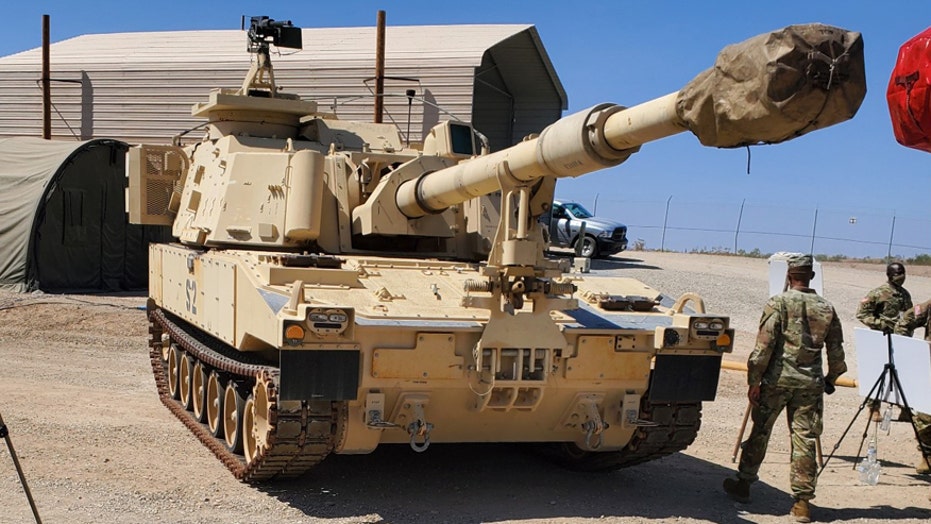https://www.foxnews.com/tech/attacking-at-speed-army-project-convergence-and-breakthrough-lightning-fast-warBy Kris Osborn | Warrior Maven

Howiter artillery vehicle at Yuma Proving Grounds, Ariz. being used in the Army's Project Convergence 2020.
The U.S. military recently conducted a live-fire full combat replication with unmanned-to-unmanned teaming guiding attacks, small reconnaissance drones, satellites sending target coordinates to ground artillery and high-speed, AI-enabled “networked” warfare. This exercise was a part of the Army’s Project Convergence 2020, a weapons and platform combat experiment which, service leaders say, represents a massive transformation helping the service pivot its weapons use, tactics and maneuver strategies into a new era.
Taking place at Yuma Proving Grounds, Arizona, Project Convergence involved live-fire war experiments aligned in three distinct phases, intended to help the Army cultivate its emerging modern Combined Arms Maneuver strategy. Through carefully coordinated attack maneuvers, the force sought to hit and disable the outer defensive perimeter of an enemy system such as its air defenses.
Second, as explained by PC20 coordinator Brig. Gen. Ross Coffman, was a “disintegration phase” wherein operational aircraft including advanced helicopters, drones and mini-drone Air Launched Effects, found and attacked the enemy’s long-range precision fires apparatus. The third and final phase, as explained by Coffman, included the use of armored vehicle ground force fires to directly engage with, fire upon and destroy enemy assets and formations.
“This follows the multi-domain operations concept of how we plan to fight,” Coffman said.
In another scenario, Next-Generation Combat Vehicles (NGCVs) attacked and destroyed enemy BMP armored vehicles. Represented by surrogate vehicles such as Humvees and Mine Resistant Ambush Protected vehicles, the NGCV sensors sent targeting data through the artificial intelligence (AI)-empowered FIRESTORM system to optimize the mode of weapons attack and destroy T-72 tanks. Drawing upon assessments made through FIRESTORM, the NGCVs were directed to engage in direct fire missions to destroy several BMP Army reconnaissance vehicles.
While the nearly instantaneous target acquisition process is greatly expedited by the AI-capable FIRESTORM system, the kill web also hinges upon the rapid work of skilled scientists and engineers who, as Army Secretary Ryan McCarthy described it, work to “rewrite software code in expeditionary combat.”
The emergence of this kind of information-driven combat is one big reason why the Army is working quickly to recruit and retain a new generation of scientists, engineers and computer experts. The Army has set up a software laboratory and expanded work with academic institutions such as Carnegie Mellon to create specific, high-tech Masters programs for promising young aspiring scientists.
“We need code writers who will need to change algorithms to adjust to new threats. We can’t wait 24 hours, we will have to change instantaneously to target,” Lt. Gen. Michael Flynn, Director, G-3/5/7, told reporters.
The Army is already moving out on new plans for Project Convergence 2021, an experiment intended to draw upon the Air Force and even international allies to network an even wider sphere of air and ground weapons.
“Next year we will have PRsM (Precision Strike Missile) and F-35,” McCarthy added.
While the F-35 will take on a larger role next year, McCarthy did refer to recent exercises connecting ground forces with Marine Corps F-35Bs as part of an assessment of multi-domain combat ops intended to synergize air-ground targeting, informational exchange and attack operations.
McCarthy explained that once weapons systems reach the right level of technical maturity, they will quickly be added to the Army’s convergence process. The Army’s Integrated Battle Command System (IBCS), a networked system of air defense sensors and radars, recently went through successful Limited User Tests and will likely be used next year.
Future Project Convergence experiments, Flynn added, will further explore how new convergence technologies and tactics will apply to larger brigade formation. Flynn explained that the conceptual basis for the convergence process rests upon three main tenets, including force posture and terrain, Multi Domain operations and convergence.
How fast might this “converged” kill web see combat? Possibly soon. While McCarthy emphasized the importance of pursuing the necessary developmental process, he did say that, based on current performance, some elements of the system could be fast-tracked on an expedited, urgent basis—should war break out. He cited the Pentagon’s lightning speed to urgently fast-track new systems to war with the Predator for Kosovo and the Mine Resistant Ambush Protected vehicles for Iraq and Afghanistan.
“We have not seen this level of energy since the 1980s with AIRLAND battle,” McCarthy said.
-- Kris Osborn is the Managing Editor of Warrior Maven and The Defense Editor of The National Interest --